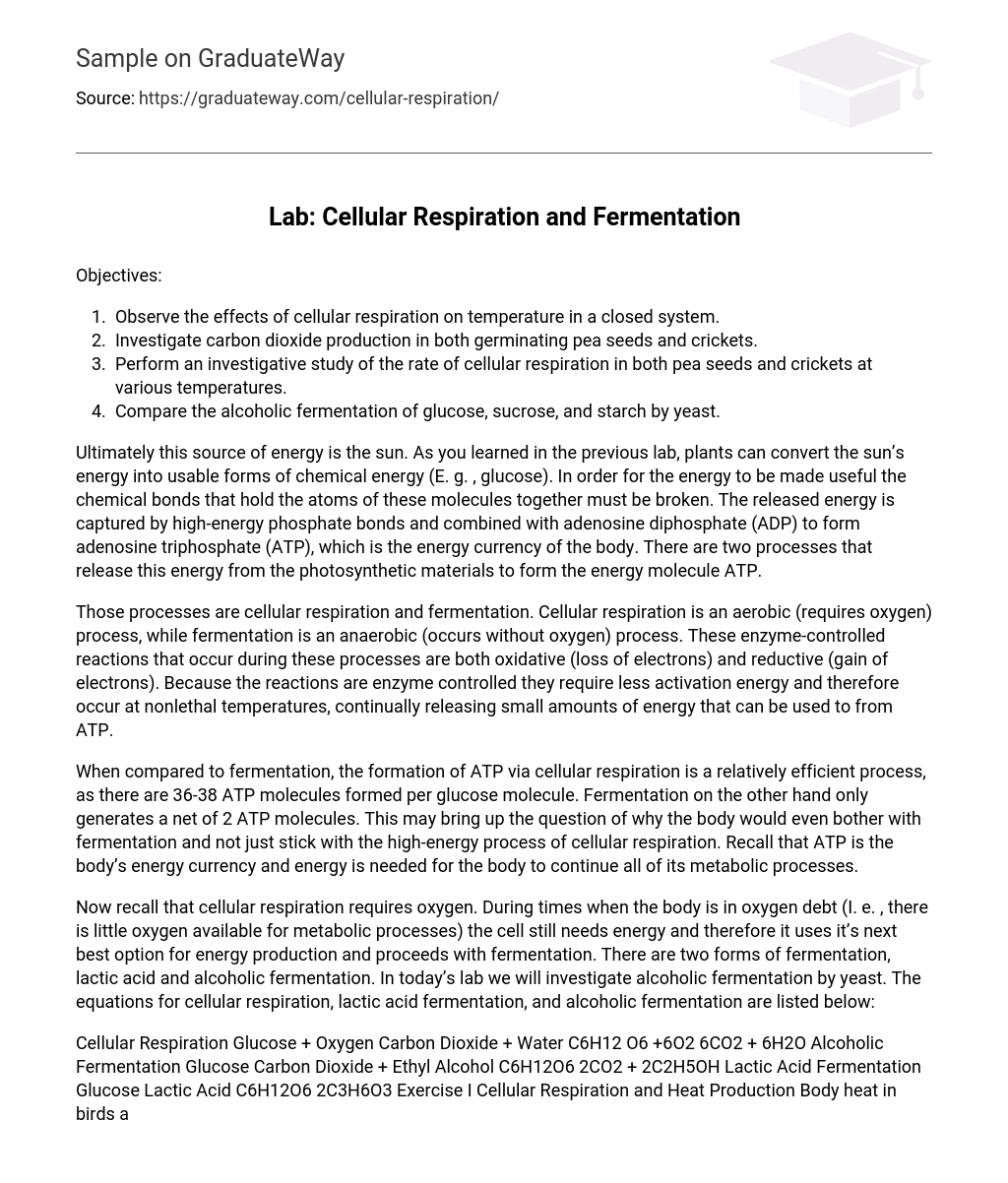Objectives:
- Observe the effects of cellular respiration on temperature in a closed system.
- Investigate carbon dioxide production in germinating pea seeds and crickets.
- Perform an investigative study of the rate of cellular respiration in both pea seeds and crickets at different temperatures.
- Compare the alcoholic fermentation of glucose, sucrose, and starch by yeast.
Ultimately, the source of energy is the sun. As you learned in the previous lab, plants can convert the sun’s energy into usable forms of chemical energy, such as glucose. To make this energy useful, the chemical bonds holding these molecules together must be broken. The released energy is captured by high-energy phosphate bonds and combined with adenosine diphosphate (ADP) to form adenosine triphosphate (ATP), which serves as the body’s energy currency. There are two processes that release this energy from photosynthetic materials to form ATP.
There are two processes that occur in cells: cellular respiration and fermentation. Cellular respiration is an aerobic process, meaning it requires oxygen, while fermentation is anaerobic and occurs without oxygen. Both of these processes involve enzyme-controlled reactions that are both oxidative (loss of electrons) and reductive (gain of electrons). Due to the fact that these reactions are enzyme controlled, they require less activation energy and can occur at nonlethal temperatures. As a result, small amounts of energy are continually released during these processes which can then be used to form ATP.
When compared to fermentation, cellular respiration is a relatively efficient process for forming ATP. For every glucose molecule, 36-38 ATP molecules are formed through cellular respiration while fermentation only generates a net of 2 ATP molecules. This raises the question of why the body would even bother with fermentation instead of sticking with the high-energy process of cellular respiration. It’s important to remember that ATP is the body’s energy currency and energy is required for all metabolic processes to continue.
Now, recall that cellular respiration requires oxygen. During times when the body is in oxygen debt (i.e., there is little oxygen available for metabolic processes), the cell still needs energy and therefore uses its next best option for energy production, proceeding with fermentation. There are two forms of fermentation: lactic acid and alcoholic fermentation. Today’s lab will investigate alcoholic fermentation by yeast. The equations for cellular respiration, lactic acid fermentation, and alcoholic fermentation are listed below:
Cellular respiration is the process by which glucose and oxygen are converted into carbon dioxide and water, as represented by the equation C6H12O6 + 6O2 → 6CO2 + 6H2O. Alcoholic fermentation results in the production of carbon dioxide and ethyl alcohol from glucose, as shown by the equation C6H12O6 → 2CO2 + 2C2H5OH. Lactic acid fermentation also converts glucose into lactic acid, represented by the equation C6H12O6 → 2C3H6O3.
During exercise, cellular respiration produces heat in birds and mammals to regulate body temperature.
Your task in this exercise is to investigate the null hypothesis that simple organisms do not produce heat as a by-product of cellular respiration. To test this null hypothesis, three 250-mL flasks have been set up. Each flask has a two-hole rubber stopper, with one hole closed off with cotton and the other housing a thermometer. One flask contains 6 live crickets, another has 6 germinating pea seeds, and the third is empty. You must read the temperature of each thermometer and decide whether to support or refute the null hypothesis.





